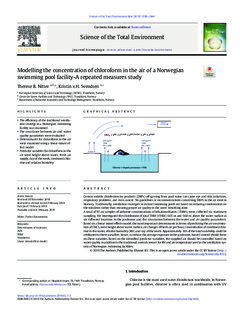| dc.contributor.author | Nitter, Therese Bergh | |
| dc.contributor.author | Svendsen, Kristin V Hirsch | |
| dc.date.accessioned | 2020-01-13T10:43:31Z | |
| dc.date.available | 2020-01-13T10:43:31Z | |
| dc.date.created | 2019-02-11T07:57:16Z | |
| dc.date.issued | 2019 | |
| dc.identifier.citation | Science of the Total Environment. 2019, 664 1039-1044. | nb_NO |
| dc.identifier.issn | 0048-9697 | |
| dc.identifier.uri | http://hdl.handle.net/11250/2635919 | |
| dc.description.abstract | Certain volatile disinfection by-products (DBPs) off-gassing from pool water can cause eye and skin irritations, respiratory problems, and even cancer. No guidelines or recommendations concerning DBPs in the air exist in Norway. Traditionally, ventilation strategies in indoor swimming pools are based on reducing condensation on the windows rather than ensuring proper air quality in the users' breathing zone. A total of 93 air samples of airborne concentrations of trihalomethanes (THMs) were collected via stationary sampling. We investigated the distribution of total THM (tTHM) 0.05 m and 0.60 m above the water surface at six different locations in the poolroom and the covariation between the water and air quality parameters. Based on a linear mixed effects model, the most important determinants in terms of predicting the air concentration of CHCl3 were height above water surface, air changes of fresh air per hour, concentration of combined chlorine in the water, relative humidity (RH) and day of the week. Approximately 36% of the total variability could be attributed to these variables; hence, to reduce the average exposure in the poolroom, hazard control should focus on these variables. Based on the identified predictor variables, the supplied air should be controlled based on water quality in addition to the traditional control censors for RH and air temperature used in the ventilation system of Norwegian swimming facilities. | nb_NO |
| dc.language.iso | eng | nb_NO |
| dc.publisher | Elsevier | nb_NO |
| dc.rights | Navngivelse 4.0 Internasjonal | * |
| dc.rights.uri | http://creativecommons.org/licenses/by/4.0/deed.no | * |
| dc.title | Modelling the concentration of chloroform in the air of a Norwegian swimming pool facility-A repeated measures study | nb_NO |
| dc.type | Journal article | nb_NO |
| dc.type | Peer reviewed | nb_NO |
| dc.description.version | publishedVersion | nb_NO |
| dc.source.pagenumber | 1039-1044 | nb_NO |
| dc.source.volume | 664 | nb_NO |
| dc.source.journal | Science of the Total Environment | nb_NO |
| dc.identifier.doi | 10.1016/j.scitotenv.2019.02.113 | |
| dc.identifier.cristin | 1675589 | |
| dc.description.localcode | © 2019 The Authors. Published by Elsevier B.V. This is an open access article under the CC BY license (http://creativecommons.org/licenses/by/4.0/). | nb_NO |
| cristin.unitcode | 194,64,91,0 | |
| cristin.unitcode | 194,60,25,0 | |
| cristin.unitname | Institutt for bygg- og miljøteknikk | |
| cristin.unitname | Institutt for industriell økonomi og teknologiledelse | |
| cristin.ispublished | true | |
| cristin.fulltext | preprint | |
| cristin.fulltext | original | |
| cristin.qualitycode | 2 | |

